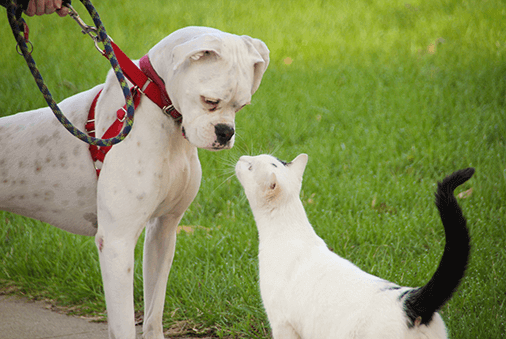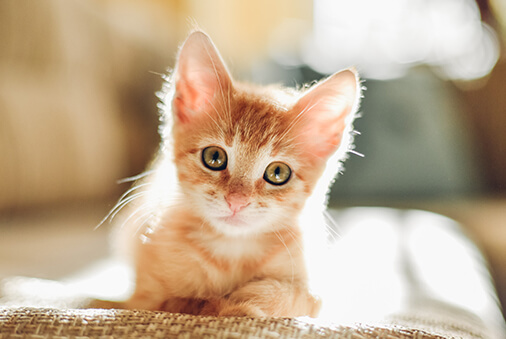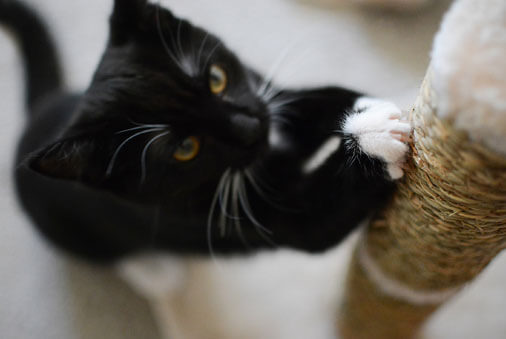Food foraging
Though our domesticated pals don’t have to hunt for sustenance like their wild ancestors, tapping into this innate behavior is a natural way to stimulate your cat. Subtly hiding her food bowl in different areas around the house will keep her stalking skills sharp, just don’t make it too difficult for her to find her food.
You can also buy sophisticated puzzle feeders or make your own using simple household items like paper towel or toilet paper rolls. Cut holes into the sides of the rolls, put treats or kibble inside, then tie up the ends so your feline has to finagle the tube to get her treats to fall out.
We know cats love boxes, so why not turn one into a puzzle feeder, too? Close the top flaps of a small box and cut some small holes in the sides of the box. With her favorite treats inside, your cat will have to stick her paws through the holes to get her reward.
You can also make holes in a plastic container, like a clean and empty spice holder, and place your cat’s kibble inside. She’ll have to roll the container to get her treats to pop out of the holes.
Empty egg cartons can make her work for her food as well. Just nest your feline’s treats in the indentations so she has to paw to remove them.
Are cats square?
As we’ve seen on many a quirky YouTube video or adorable Instagram pic, cardboard boxes, suitcases, sinks, storage bins, cupboards, sweater drawers, even wide-necked flower vases all vie for Favorite Feline Hiding Place.
Unlike their big-cat relatives, our house cats seem to prefer huddling in small, confined spaces rather than in the midst of loud and possibly dangerous wide-open spaces. This behavior most likely stems from kittens snuggling with their mom and littermates when they’re born.
Close contact with containers, such as boxes, appears to have a soothing effect on cats, much like swaddling a human baby. Dutch researchers tested this theory by giving shelter cats their own boxes to retreat to. According to the study, ”Cats with boxes adapted to their new environment more quickly compared to a control group without boxes.” They concluded that the felines who had access to boxes were less stressed.*
Geometry lesson: Turns out you don’t even need a three-dimensional container. You can create a virtual square (or other geometric shape) using duct tape on the floor. Try it at home and see if your feline naturally finds her way to the center of the shape and chills there.
Circles are also cat-friendly. Place hula-hoops, electronic cords and other small items in circle shapes on the floor or ground. Try different sized circles to see if your cat prefers smaller or larger ones.
Every cat is unique so try other shapes. Your furry pal may love sitting in a triangle or rectangle shape. Be patient if your cat is oblivious at first. You could place a treat in the center of the shape, but try to draw her attention without adding an extra incentive.
On top of the world, ma 
Cats need their vertical space, too. Taking cues from their wild ancestors, cats love to climb trees; it makes them feel safe and, above it all, it’s where they can get a good view of their world.
There are plenty of cat trees available with varying degrees of bells and whistle. Some cat climbs even have built-in shelves for food and water bowls if your feline likes to eat on higher ground. Hiding catnip or crinkly toys in your cat’s tree can make her ordinary toys feel new again now that they’re in a new environment.
Climb and swipe: You can also make DIY shelves covered with faux fur or other soft material and stagger them at different heights on the wall. Attach a swipe toy, like a string or feather wand, to the lowest shelf as a great way to occupy your cat’s mind and body when you’re not there to play with her.
Be sure whatever cat furniture you buy or construct on your own is made of high-quality material so it doesn’t break easily and possibly injure your furry pal.
Indoor adventure land: You can also buy or make tunnels and fabric tubes for your feline to run through. Everyday items like cutout boxes and claw-proof, recyclable bags can be used.
Your pal might even like to jump through hoops for you; just start out with easy, low jumps and be sure your cat is healthy enough to perform such calisthenics. Your veterinarian can recommend safe activities for your cat based on her current health.
Waterpark: After your feline runs her course, she may want to cool off in a homemade kitty pool with a surprise inside. Fill a bathroom sink or large portable basin with water and put some colorful marbles at the bottom. Add a few ping pong balls or safe, wind-up water toys as floaters on top. Your feline will have a hard time extracting the marbles, but she’ll probably have fun splashing around.
Virtual games, real rewards
It’s an app world and we’re just living in it. So of course there are cat apps to engage and entertain our feline friends. While your feline may enjoy interacting with techie apps, it’s best to reward her after with a real toy she can actually touch and catch.
Remember, felines are prey animals who love to stalk and catch so add a feather, dangling toy or string as a reward for an app well-played.
The same goes for laser pointers and other light gadgets. They’re great for getting your cat to do her daily jumps, but they come up empty handed because she’ll never catch the light. So, remember to keep the light out of your furry pal’s eyes and reward her with a tangible toy or treat when she’s done chasing light beams.






